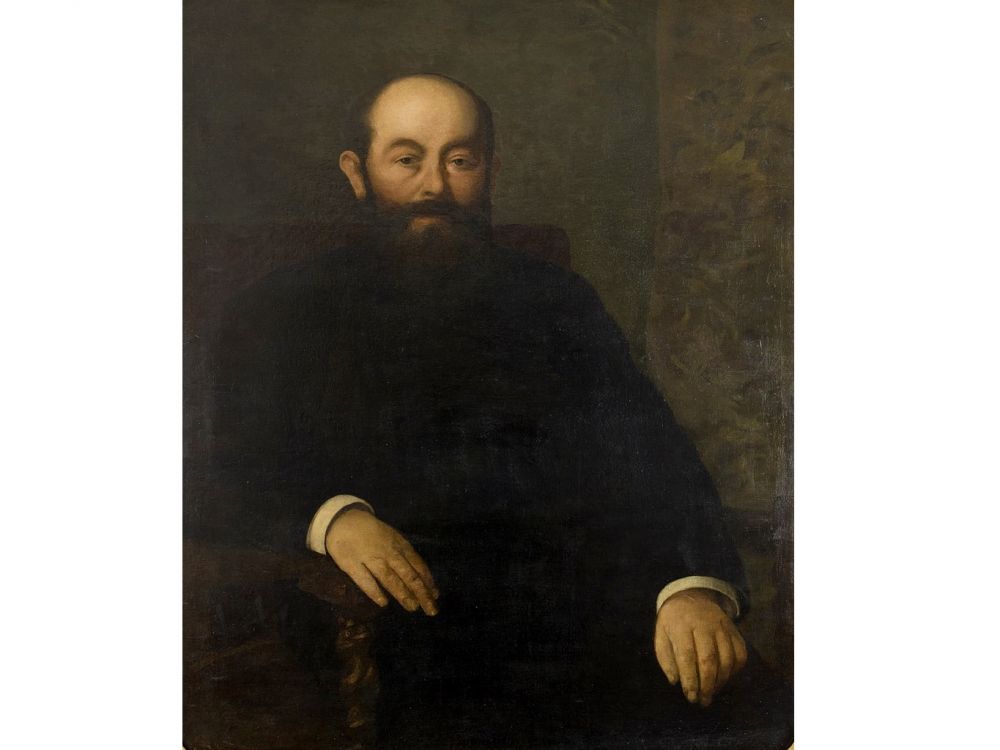 25 sierpnia. Rocznica urodzin Izraela Poznańskiego
25 sierpnia. Rocznica urodzin Izraela Poznańskiego
Przemysław Batorski
188 lat temu urodził się Izrael Poznański, jeden z największych fabrykantów Łodzi II połowy XIX wieku. Uważany przez niektórych za wyzyskiwacza, przez innych za wybitnego biznesmena i filantropa, zachowywał żydowskie tradycje, w których był wychowany, i na produkcji wyrobów bawełnianych budował prywatne imperium.
.
 Stanisław Heyman, Portret Izraela Kalmanowicza Poznańskiego, 1891 r. Muzeum Miasta Łodzi, Wikipedia, domena publiczna
Stanisław Heyman, Portret Izraela Kalmanowicza Poznańskiego, 1891 r. Muzeum Miasta Łodzi, Wikipedia, domena publiczna
Urodzony w 1785 r. Kalman z Kowala koło Włocławka, kramarz towarów łokciowych (tkanin sprzedawanych w łokciach długości), w młodych latach nie posiadał nazwiska – dopiero na mocy ukazu króla pruskiego zaczął być nazywany Poznańskim. Około 1830 r. przeniósł się wraz z żoną i pięciorgiem dzieci do Aleksandrowa, gdzie zajmował się farbieniem tkanin wełnianych i handlem tasiemkami. W 1833 r. urodził się jego najmłodszy syn – Izrael. Rok później, ze względu na wysokie cła wprowadzone przez cara na eksport towarów z Królestwa Polskiego do Rosji, rodzina przeprowadziła się do sąsiedniej Łodzi[1].
Już od młodości Izrael był przygotowywany przez ojca do objęcia zarządu fabryki. Chłopiec został wysłany do niemiecko-rosyjskiej szkoły, leżącej poza dzielnicą żydowską, dzięki czemu poznał, obok hebrajskiego i polskiego, także niemiecki i rosyjski, i nawiązał kontakt ze światem gojów. W 1851 r. Kalman przekazał firmę 19-letniemu Izraelowi, wtedy już doświadczonemu tkaczowi. Doprowadził też do ślubu syna z Leonią Hertz z Warszawy, która wniosła do małżeństwa posag w wysokości 750 rubli. Izrael posiadał wtedy warsztaty tkackie o wartości 500 rubli i murowany dom przy Rynku Starego Miasta zbudowany przez ojca dla licznej rodziny.
![lodz_pocz_xx_wieku_polona_fb.jpg [650.20 KB]](https://www.jhi.pl/storage/image/core_files/2021/8/25/013f4bb3b6cbad822d490cf1168439b5/jpg/jhi/preview/lodz_pocz_xx_wieku_polona_fb.jpg) Łódź, pocztówka z początku XX wieku. Polona
Łódź, pocztówka z początku XX wieku. Polona
Na początku lat 50. Rosja otworzyła swój rynek na towary z Królestwa Polskiego. Jedną z przyczyn była klęska imperium w wojnie krymskiej, prowadzonej z Anglią i Francją, która napędziła wydatki cara i inflację. Rewolucja przemysłowa na zachodzie Europy przyniosła wynalazek maszyny przędzalniczej, która umożliwiła masową produkcję tkanin. Łódź, liczącą około 1820 r., przed uprzemysłowieniem, niecały tysiąc mieszkańców, w 1870 r. zamieszkiwało już ponad 100 tysięcy osób. Lawinowy napływ ludności oznaczał, że otwierały się niebywałe okazje dla przedsiębiorców.
Izrael zainwestował w maszyny tkackie. Nowoczesne krosna podłączył do kieratu poruszanego przez konia, potem zmechanizował. Wkrótce otworzył dwa kolejne zakłady produkcyjne i pod koniec lat 60. zatrudniał już 300 tkaczy. Jednocześnie kupował grunty i stawiał kamienice. Na parcelach wzdłuż ul. Ogrodowej zaplanował budowę ogromnej fabryki i osiedla dla robotników. Kompleks o powierzchni blisko 30 hektarów powstawał w latach 70. XIX wieku. W ukończonej fabryce Poznańskiego, podobnej do średniowiecznego zamku, pracowało około 6 tysięcy robotników, z czego dwie trzecie mieszkały w pobliskim osiedlu, wyposażonym także w szkołę i szpital.
Kiedy na skutek nacisków kupców rosyjskich, chcących zaszkodzić konkurencji z Polski, car wprowadził wysokie cła na bawełną importowaną z Ameryki, Izrael Poznański skierował swojego syna Ignacego do centralnej Azji, by pozyskać tam tańszych dostawców surowca. Wkrótce sprowadzał bawełnę nie zza oceanu, ale z Persji i Chanatu Buchary. Po raz kolejny z powodzeniem dostosował się do zmiennych okoliczności.
![Łódź_Majewski_fabryka_Poznańskiego_wiki.jpg [95.60 KB]](https://www.jhi.pl/storage/image/core_files/2021/8/25/6ea6f828481b700e1b7a449e93e3f775/jpg/jhi/preview/%C5%81%C3%B3d%C5%BA_Majewski_fabryka_Pozna%C5%84skiego_wiki.jpg) Fabryka Izraela Poznańskiego w Łodzi, ul. Ogrodowa 15/21, ok. 1895 r. / Fotografia Bronisława Wilkoszewskiego / Wikipedia
Fabryka Izraela Poznańskiego w Łodzi, ul. Ogrodowa 15/21, ok. 1895 r. / Fotografia Bronisława Wilkoszewskiego / Wikipedia
Nie wszystkie strony działalności Poznańskiego można jednak określić jako sukces. W fabrykach zdarzały się liczne wypadki, nawet śmiertelne. Właściciel, co prawda, płacił rodzinom zmarłych robotników odszkodowania o wartości nawet kilkuletnich zarobków. Zarzucano mu też, że produkuje tanią tandetę, chociaż inni twierdzili, że z jego fabryk wychodzą produkty dobrej jakości, na które po prostu stać było bardzo wielu klientów. Poznańskiego oskarżano też o podpalanie własnej fabryki w celu wyłudzenia odszkodowań. Dziś trudno ocenić, ile z tych zarzutów miało podstawy, a ile było oszczerstwami jego przeciwników. Czarną legendę Poznańskiego i innych fabrykantów łódzkich podsycał też Władysław Reymont w Ziemi obiecanej.
W 1889 r. firma zmieniła nazwę na Towarzystwo Akcyjne Wyrobów Bawełnianych I. K. Poznańskiego. Kapitał zakładowy wynosił astronomiczną kwotę 5 milionów rubli, co czyniło przedsiębiorstwo jednym z największych w Polsce. Dla porównania przypomnijmy, że w Lalce Bolesława Prusa, której akcja dzieje się w latach 1878-1879, kamienicę w Warszawie można kupić za jedyne 90 tysięcy rubli.
Poznański pełnił też liczne funkcje w społeczności żydowskiej – był m.in. prezesem gminy, należał do dozoru bożniczego, podarował gminie ziemię pod cmentarz żydowski. W ostatnich latach życia rozpoczął intensywną działalność charytatywną – sfinansował budowę szpitala starozakonnych, wspierał szkolnictwo żydowskie i teatr, fundował stypendia dla zdolnych uczniów[2], był mecenasem sztuki, kupował obrazy m.in. Samuela Hirszenberga, który wystroił także salę balową i salę jadalną w pałacu fabrykanta.
W 1888 r. Poznański zaczął budowę pałacu fabrykanckiego przy ul. Ogrodowej 15. Rezydencja w stylu eklektycznym, zwana „łódzkim Luwrem”, stała się największym i najokazalszym tego typu budynkiem w mieście. Jej budowę zakończono dopiero po śmierci fundatora. Pałac mieścił rozmaite urzędy, a od 1975 r. jest siedzibą Muzeum Miasta Łodzi.
Izrael Poznański zmarł w 1900 r. Łódź liczyła wtedy już ponad 300 tysięcy mieszkańców, przed I wojną światową – już pół miliona. Synowie i dalsi krewni „króla bawełny”, którzy przejęli imperium, roztrwonili pieniądze na kolejne pałace. Ciosem dla biznesu była także I wojna światowa (Niemcy zniszczyli fabrykę) oraz rewolucja w Rosji, w wyniku której Poznańscy utracili najważniejszy rynek zbytu – inwestycje na Wschodzie, tak intratne dekady wcześniej, pociągnęły za sobą upadek rodu. W latach 30. Towarzystwo przejął Banca Commerciale Italiana, a kres jego działalności położyła powojenna nacjonalizacja.
„Poznański to postać pełna sprzeczności” – pisze Michał Matys. – „Z jednej strony, religijny Żyd, przestrzegający tradycji, z drugiej strony – Europejczyk pełną gębą, który wykorzystywał najnowsze zdobycze techniki do tego, aby stworzyć najnowocześniejsze przedsiębiorstwo na terenie imperium carskiego”[3].
Przypisy:
[1] Informacje o Izraelu Poznańskim i jego rodzinie podaję za: Michał Matys, Łódzka fabryka marzeń. Od afery do sukcesu, Warszawa 2011, s. 17-67; Rafał Żebrowski, Poznański Izrael Kalmanowicz, Polski Słownik Judaistyczny online, dostęp 25.08.2021.
[2] Poznański Izrael Kalmanowicz, portal „Wirtualny Sztetl”, https://sztetl.org.pl/pl/biogramy/5217-poznanski-izrael-kalmanowicz, dostęp 25.08.2021 r.
[3] M. Matys, dz. cyt., s. 17.
Zawartość publikowanych artykułów i materiałów nie reprezentuje poglądów ani opinii Reunion’68,
ani też webmastera Blogu Reunion’68, chyba ze jest to wyraźnie zaznaczone.
Twoje uwagi, linki, własne artykuły lub wiadomości prześlij na adres:
webmaster@reunion68.com




